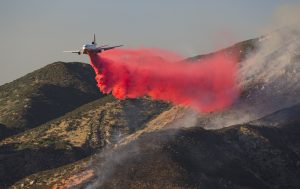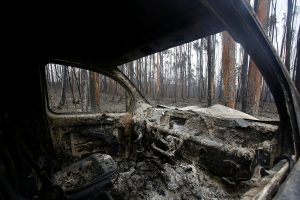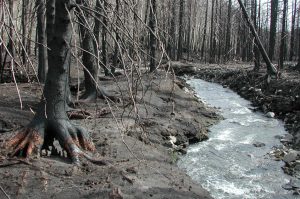Water pollutants
Ash
Ash from burned wood fuel contains nutrients (nitrates and phosphates), trace metals and Polycyclic Aromatic Hydrocarbons (PAHs). During harsh weather conditions such as blowing wind at high speeds tend to transport ash and deposited on open surface waters, which later releases contaminants as it dissolves in water and eventually changes pH and color. The increased concentration of dissolved organic carbon (DOC) in ash is a major concern in drinking water since the chemicals used in treatment processes react with dissolved organic carbon producing several toxins which are carcinogenic (Writer & Murphy, 2012).
Sediments
Drinking water supplies are impaired during a heavy storm following a wildfire because the burned areas are left open without vegetation, thus more prone to greater rates of erosion and increasing sediment accumulation downstream in reservoirs. Siltation of the reservoir eventually reduces its capacity as well as reduced water quality which increases maintenance, raw water distribution and treatment costs (USGS, 2018).
Water Pollution Pathways
High concentrations of white ash and burned soil organic matter are produced under high severe fire. These products are more susceptible to transportation by wind, erosion, overland runoff flow and leaching. There are different pathways through which the pollutants end in surface or groundwater which includes;
- Ash deposition by wind
- Ash desorption with chemical constituents and transportation by runoff
- Pollutant adsorption and transportation by sediments
- Sediment transport by Runoff
- Aerial discharge of fire retarding chemicals by fire fighters
- Ash desorption and pollutants leaching into groundwater



Figure 4: Wildfire pollutants (first images) (Photo credits: Joseph Serna & Alan Taylor) and stream pollution by pathways (below image) (Baldon et al., 2014)
